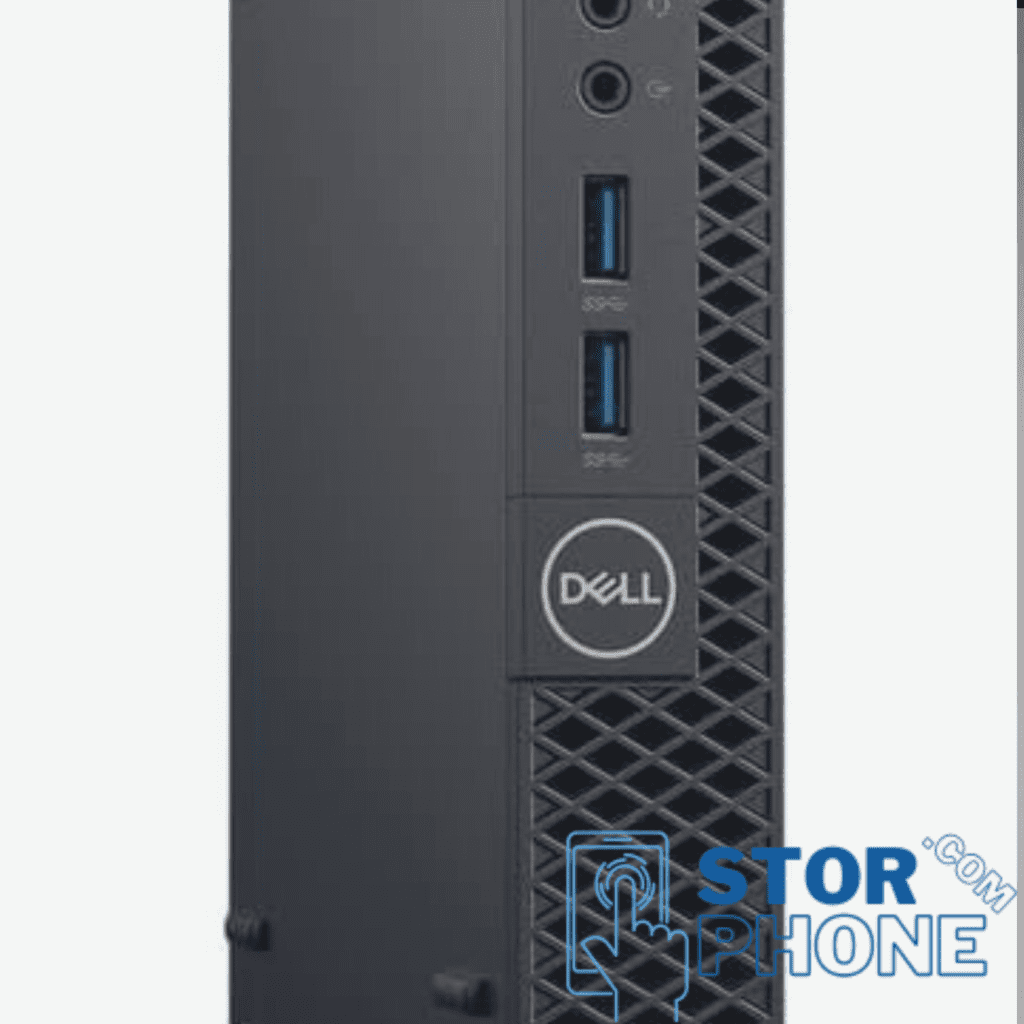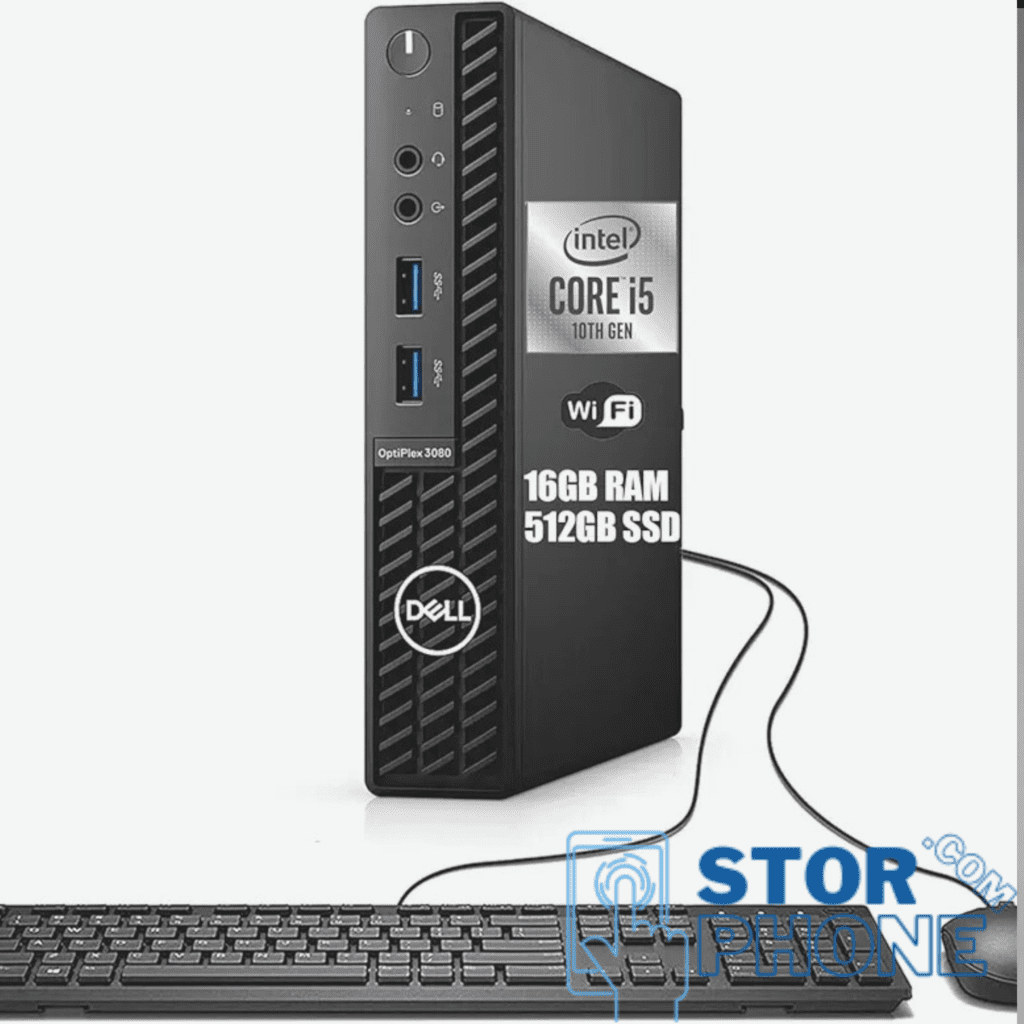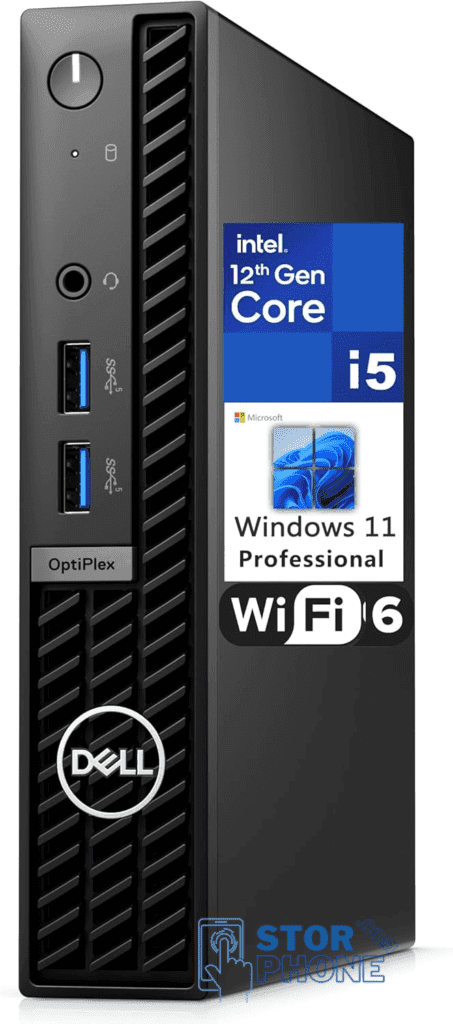If you’re diving into the world of Dell micro desktops, you’re likely looking for compact computing solutions that balance performance, efficiency, and space-saving design. In this first part of our deep dive, we’ll tackle the most important questions surrounding Dell’s micro PCs—covering everything from their hardware capabilities to their best use cases. Whether you’re considering one for business, home office, or specialized tasks, this guide will help you make an informed decision.
What is OptiPlex 3060 Micro?

إن Dell OptiPlex 3060 Micro is a compact business desktop designed for efficiency and space-saving setups. It features Intel Core processors, SSD storage, and remote management capabilities.
Key Specifications:
- Processor: Up to Intel Core i5-8500T (Six-Core, 2.1 GHz).
- Memory: Supports up to 32GB DDR4 RAM (2666MHz).
- Storage: 1 internal 2.5” HDD or SSD options.
- Power Supply: 65W external PSU (for 35W CPU models).
- Management: Dell Client Command Suite for remote system management.
This model is ideal for business users, home offices, and compact workstations. You can find more details on Dell’s official site or check out its rack compatibility and specs.
You can buy it from Amazon:
What is a Dell OptiPlex 3080 Micro?

إن Dell OptiPlex 3080 Micro is a compact business desktop designed for efficiency and space-saving setups. It features 10th Gen Intel Core processors, SSD storage, and advanced security features.
Key Specifications:
- Processor: Up to Intel Core i5-10600T (6 cores, 12 threads, 2.4 GHz to 4.0 GHz).
- Memory: Supports up to 64GB DDR4 RAM (2666MHz).
- Storage: Options include M.2 PCIe NVMe SSDs and 2.5-inch SATA HDDs.
- Graphics: Intel UHD Graphics 610/630 (integrated).
- Operating System: Windows 11 Pro, Ubuntu, or NeoKylin (China only).
- Security: TPM 2.0, Dell Client Command Suite, and McAfee Small Business Security.
This model is ideal for business users, home offices, and compact workstations. You can find more details on Dell’s official site or check out its setup and specifications.
you can follow our article about asus expertcenter pn64 2025.
What is the difference between micro ATX and mini DTX?
The Micro ATX and Mini DTX motherboard form factors differ in size, expansion slots, and compatibility.
Micro ATX:
- Dimensions: 9.6 × 9.6 inches (244 × 244 mm).
- Expansion Slots: Supports up to 4 PCIe slots.
- Compatibility: Fits in ATX and Micro ATX cases.
- Use Case: Ideal for mid-range gaming PCs and workstations.
Mini DTX:
- Dimensions: 8 × 6.7 inches (203 × 170 mm).
- Expansion Slots: Supports up to 2 PCIe slots.
- Compatibility: Fits in Mini-ITX and DTX cases.
- Use Case: Designed for compact builds and HTPCs (Home Theater PCs).
The Micro ATX is larger and offers more expansion slots, making it better for gaming and productivity setups. The Mini DTX is smaller and optimized for space-saving builds while still allowing two expansion slots.
What is the difference between micro mini computer?
The difference between microcomputers and mini computers lies in their size, processing power, and intended use.
Microcomputer:
- Definition: A small, personal computer powered by a single-chip processor (e.g., laptops, desktops, and tablets).
- Processing Power: Built for individual users, typically with a single-user operating system.
- Examples: Laptops, desktops, smartphones, Raspberry Pi, and mini PCs.
- Use Case: Personal computing, gaming, office work, and entertainment.
Mini Computer:
- Definition: A mid-range computer used for multi-user environments, larger than microcomputers but smaller than mainframes.
- Processing Power: Can handle multiple users simultaneously, used for business, scientific computing, and enterprise tasks.
- Examples: IBM AS/400, PDP-11, VAX computers (historical models).
- Use Case: Server management, database hosting, and industrial applications.
In short, a microcomputer is a personal-use device, while a mini computer is a multi-user system built for enterprise-level computing.
You can buy it from Amazon:
What is the difference between Dell 5000 and 7000?

The Dell 5000 and 7000 series differ in performance, build quality, and features. Here’s a breakdown:
Dell 5000 Series:
- Mid-range option with solid performance.
- Intel Core i5/i7 processors (depending on the model).
- DDR4 RAM support.
- Standard display options (FHD, touchscreen available).
- Good for everyday tasks, office work, and light gaming.
Dell 7000 Series:
- Premium build with higher-end specs**.
- Intel Core i7/i9 processors (better performance).
- DDR5 RAM support (faster memory).
- Higher-resolution displays (QHD or OLED options).
- Better cooling and battery life.
- Ideal for professionals, creators, and power users.
If you need solid performance at a reasonable price, the 5000 series is a great choice. If you want top-tier specs and premium features, the 7000 series is the way to go. You can check out more details here و here.
You can buy it from Amazon:
What is micro form factor plus?
إن Dell OptiPlex Micro Form Factor Plus is an ultracompact commercial desktop designed for high performance in a space-saving design. It offers Intel Core Ultra processors, DDR5 memory, and advanced connectivity options.
الميزات الرئيسية:
- Processor: Up to Intel Core i9.
- Memory: Supports DDR5 RAM for faster performance.
- Storage: Two M.2 SSD slots with PCIe 4 support for high-speed data transfer.
- Ports: Three native DisplayPorts, five USB ports, including one USB-C.
- Compact Design: Ideal for business environments and tight workspaces.
You can explore more details on Dell’s official site.
What is the difference between Microusb and USB C?
The difference between Micro USB and USB-C mainly comes down to design, speed, and functionality.
Micro USB:
- Older standard used for charging and data transfer.
- Slower speeds (USB 2.0 up to 480 Mbps, USB 3.0 up to 5 Gbps).
- One-way connection (must be plugged in a certain direction).
- Common in older smartphones, accessories, and budget devices.
USB-C:
- Newer and faster standard with reversible design (can plug in either way).
- Much higher data speeds (USB 3.1 up to 10 Gbps, USB 4 up to 40 Gbps).
- Better power delivery (supports fast charging and higher wattage.
- Used in modern laptops, smartphones, tablets, and gaming consoles.
In short, USB-C is faster, more versatile, and future-proof, while Micro USB is an older technology with limitations.
What is the difference between micro computer and micro controller?
The difference between a microcomputer and a microcontroller comes down to functionality, design, and use case.
Microcomputer:
- Definition: A small, personal computer that operates as a standalone system.
- Components: Includes a processor (CPU), memory (RAM), storage (SSD/HDD), and input/output interfaces.
- Purpose: Used for general computing tasks, like web browsing, gaming, and office work.
- Examples: Laptops, desktops, Raspberry Pi, mini PCs.
Microcontroller:
- Definition: A compact, embedded system designed to control specific tasks in electronics.
- Components: Contains a CPU, RAM, ROM, and I/O ports in a single chip.
- Purpose: Used in automation, robotics, and embedded systems to control devices like washing machines, smart thermostats, and IoT devices.
- Examples: Arduino, ESP32, PIC microcontrollers.
In short, a microcomputer is a general-purpose computing device, while a microcontroller is designed for specific tasks and embedded systems.
you can follow our article about best studio monitors for 400 on Amazon 2025.
What is the difference between micro USB and Micro B?
The difference between Micro USB and Micro-B comes down to their connector shape and intended use.
Micro USB:
- General term for a small USB connector used in mobile devices.
- Typically refers to Micro-A and Micro-B connectors.
- Found in older smartphones, tablets, and accessories.
Micro-B:
- Specific type of Micro USB connector.
- Has a distinct trapezoidal shape with two sections (used in USB 3.0 ports).
- Mainly found in external hard drives, cameras, and printers.
In short, Micro USB is the broader category, while Micro-B is a specific type of Micro USB connector.
What does OptiPlex mean on a computer?
OptiPlex is a line of business-oriented desktop computers developed by Dell. The name OptiPlex is a combination of “optimal” and “-plex”, reflecting its focus on efficiency and enterprise use. These computers are designed for corporate offices, healthcare, government, and education markets, offering reliability, security, and manageability.
Key Features of OptiPlex Computers:
- Business-grade components (Intel Core processors, Gigabit Ethernet, DisplayPort).
- Tool-less chassis for easy upgrades and maintenance.
- Remote management capabilities (Intel vPro, Dell Client Command Suite).
- Customizable configurations for CPU, RAM, storage, and wireless options.
OptiPlex desktops come in Micro, Small Form Factor (SFF), and Tower designs, catering to different workspace needs.
What is the difference between micro mini mainframe supercomputer?
The differences between microcomputers, minicomputers, mainframes, and supercomputers come down to their size, processing power, and intended use.
Microcomputer:
- Definition: A personal computer designed for individual use.
- Processing Power: Uses a single-chip processor with moderate power.
- Examples: Laptops, desktops, tablets, Raspberry Pi, and mini PCs.
- Use Case: Personal computing, office work, entertainment.
Minicomputer:
- Definition: A mid-range computer, larger than a microcomputer but smaller than a mainframe.
- Processing Power: Can handle multiple users at once, often used in business.
- Examples* IBM AS/400, PDP-11, VAX computers.
- Use Case: Business applications, database management, industrial control systems.
You can buy it from Amazon:
Mainframe:
- Definition: A large-scale, high-performance computer used for big data processing.
- Processing Power: Supports thousands of users simultaneously, with massive storage and fast processing speeds.
- Examples: IBM Z-Series, Fujitsu GS21.
- Use Case: Banks, governments, and enterprises needing large-scale data management.
Supercomputer:
- Definition: The most powerful computing system, designed for extreme processing tasks.
- Processing Power: Trillions of calculations per second, used for scientific research, weather forecasting, AI.
- Examples: IBM Summit, Fugaku, Cray Supercomputers.
- Use Case: Climate modeling, space exploration, nuclear simulations, AI training.
In short, microcomputers are for personal use, minicomputers for business, mainframes for large-scale transactions, and supercomputers for scientific breakthroughs.
In this first part of our deep dive into Dell micro desktops, we’ve tackled key questions about their hardware, performance, and ideal use cases. These compact computing solutions pack a surprising punch, making them a versatile choice for professionals, home users, and specialized tasks.
As technology evolves, Dell continues to refine its micro PC lineup, ensuring users get maximum efficiency in a minimal footprint. In the next part, we’ll explore more advanced aspects, including customization options, thermal performance, and how they compare to competing brands.














